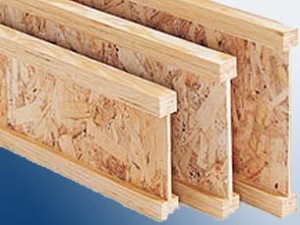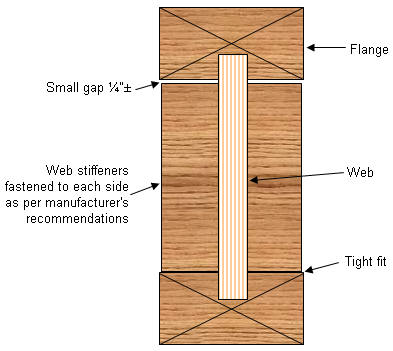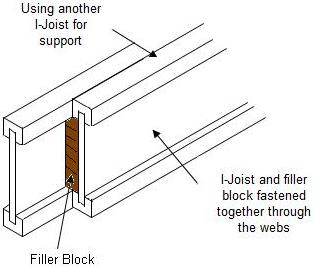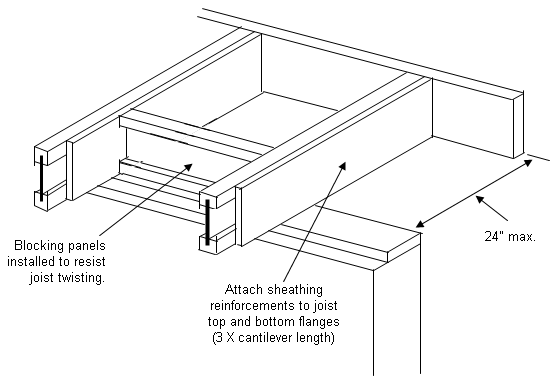The use of wood I-Joists (Figure 6) has become very popular in house construction. They can be engineered to cover wide spans, are lighter in weight, are straight and true and are much less expensive than solid lumber.

Figure 6 - I-Joist construction
It is important that extra consideration be used when considering the use of I-Joists as the floor support for a cantilevered floor. If the cantilevered floor carries the dead weight roof load, a substantial amount of stress is created at the fulcrum of the wood I-Joist. Under these circumstances the web portion of the I-Joist may not be able to take the added load and bending stress creating a structural failure of the I-Joist.
Web Stiffeners:
In order to make the I-Joist stronger at the fulcrum point, over the foundation wall, web stiffeners should be added to the I-Joists. The use of web stiffeners adds structural support to the I-Joists at its most vulnerable points.
Web stiffeners are pieces of plywood or lumber blocks that are mounted to each side of the I-Joist in between the upper and lower flanges, as shown in Figure 7. To ensure that the blocking does not have a detrimental affect when the I-Joist expands and contracts due to moisture and temperature, a ± 1/4 inch gap is generally left between the top of the blocking and the bottom of the upper flange.

Figure 7 - Installation of web stiffeners on an I-Joist
Note: It is important to follow all manufacturer's instructions with respect to the fastening, placement and sizing of any web stiffeners.
For the web stiffeners to perform properly they must be fastened to the I-Joist web in such a manner that the I-Joist web and the web stiffeners work as one unit. By doing so, you are increasing the structural load carrying capacity of the I-Joist web.
I-Joist Reinforcement
If it is necessary for I-Joists to carry additional loads because of cantilever construction. The load carrying abilities of an I-Joist can be enhanced in three manners:
- The addition of sheathing material, such as plywood, installed across the entire depth of the I-Joist, as shown in Figure 9. The sheathing is fastened to both the upper and lower I-Joist flanges.
- The addition of a second I-Joist running parallel to the initial cantilever I-Joist and coupled together, through the web surfaces, using a filler block, as shown in Figure 8.
The installation of the sheathing material should start at the outside end of the cantilever and extend at least three times the length of the cantilever. As an example; if the cantilever is 2 feet, the sheathing should extend at least 6 feet over the tail portion of the I-Joist.
For added strength the sheathing material can be placed on both sides of the I-Joist flanges.

Figure 8 - Cantilever I-Joist reinforcement
- Blocking panels, made from sections of I-Joists should be installed along the foundation wall to prevent the cantilever I-Joists from twisting under heavy loads, as shown in Figure 9. For an I-Joist to carry the load it must remain perfectly upright or the load is not transferred from the upper flange, through the web to the lower flange.

Figure 9 - Cantilever I-Joists reinforced with sheathing and blocking panels
Installing the I-Joist blocking panel supports the upper wall and floor system as it passes over the foundation.
